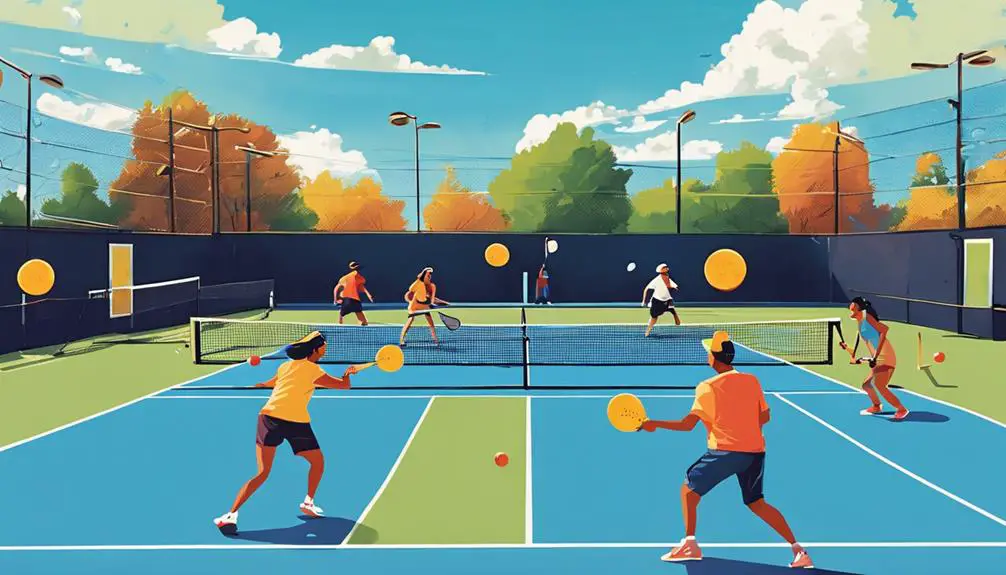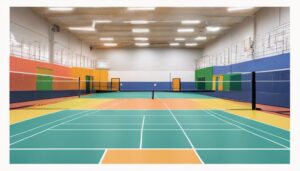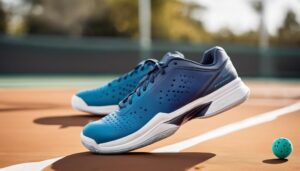Paddle ball and pickleball are both exciting racquet sports, but they have unique characteristics. Paddle ball originated in the 1940s and focuses on agility and creativity, often played on larger courts with fewer restrictions. In contrast, pickleball combines elements from tennis and badminton, promoting strategic gameplay with a smaller court and specific rules, including a non-volley zone. While both games encourage social interaction and are accessible for all skill levels, pickleball is rapidly growing in popularity. If you’re curious about which sport aligns better with your preferences, you’ll uncover more insights on their differences.
Overview of Paddle Ball

Paddle ball, often overshadowed by its more popular counterpart, pickleball, offers a unique twist on racquet sports that’s both engaging and accessible. Its history dates back to the 1940s, originating in the beaches of California, where it began as a simple game using wooden paddles and a rubber ball. You’ll find that paddle ball‘s evolution reflects a desire for freedom in play, with variations sprouting up across different cultures and regions.
As you explore the paddle ball variations, you’ll discover two main forms: beach paddle ball and court paddle ball. Beach paddle ball is typically played on sandy shores, emphasizing agility and reflexes, while court paddle ball is played on a defined court, often with walls, allowing for more strategic plays. Each variation brings its own set of rules and gameplay dynamics, giving players the chance to choose their preferred style of play.
In essence, paddle ball encourages creativity and adaptability. It’s not just a game; it’s a method of expression that thrives on the freedom of movement and spontaneity. Whether you’re playing casually on the beach or competitively on a court, the game’s roots in community and fun shine through. As you dive deeper into the world of paddle ball, you’ll appreciate how its history and variations contribute to a rich tapestry of recreational sports, offering a rejuvenating alternative to the more structured games like pickleball.
Overview of Pickleball
If you’re looking for a sport that combines elements of tennis, badminton, and table tennis, pickleball might just be what you need. Emerging in the mid-1960s, pickleball has roots in American ingenuity, created by three dads in Washington state who sought to entertain their kids. Since then, it’s evolved into a beloved pastime for all ages, with a rapidly growing player base. Understanding its history can enrich your appreciation for the game and the community it’s built.
Pickleball is played on a court similar to a badminton court, but the rules are distinct. You’ll use a paddle and a plastic ball with holes, which gives it a unique feel. One of the most attractive aspects of pickleball is its accessibility. You don’t have to be a seasoned athlete to enjoy playing; beginners can quickly pick up the essential skills and strategies.
When it comes to pickleball strategies, the gameplay revolves around placement, anticipation, and teamwork, especially in doubles matches. Players often focus on controlling the net, volleying effectively, and using soft shots to set up for more aggressive plays. These strategies not only enhance your performance but also promote a more engaging and competitive experience.
Court Dimensions and Setup
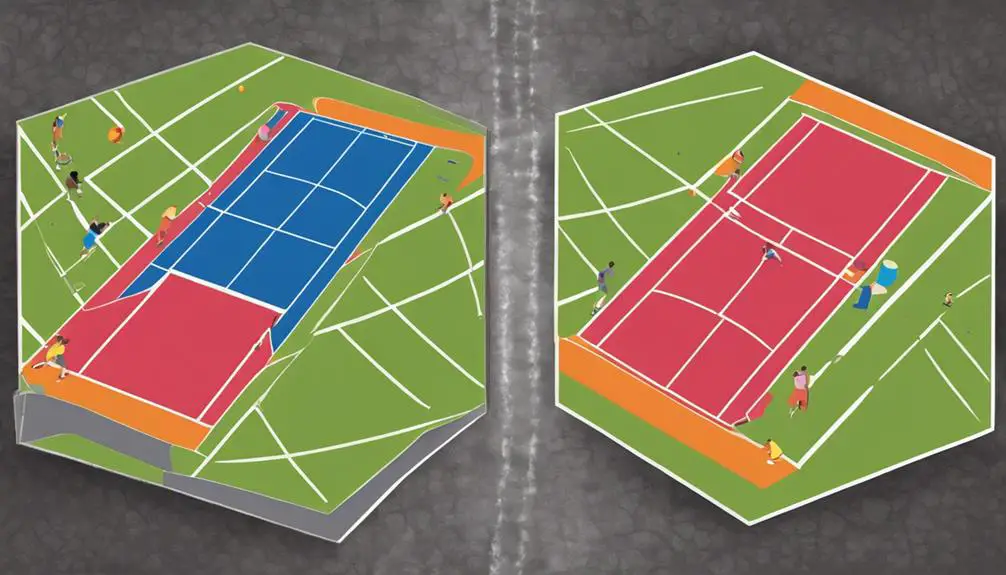
Understanding the court dimensions and setup is essential for getting the most out of your pickleball experience. The layout of the court greatly influences gameplay, and knowing these specifics can enhance your performance. A standard pickleball court measures 20 feet wide by 44 feet long for both singles and doubles play, while the net height is 36 inches at the sidelines and 34 inches at the center.
When you consider paddle ball, the court dimensions differ considerably. Here’s a quick comparison of the two sports:
| Aspect | Pickleball | Paddle Ball |
|---|---|---|
| Court Dimensions | 20 ft x 44 ft | 20 ft x 50 ft |
| Net Height | 36 in sides, 34 in center | 40 in |
| Court Surface Types | Hard, grass, or indoor courts | Typically hard surfaces |
| Service Area | 7 ft non-volley zone | N/A |
| Game Format | Singles and doubles available | Primarily singles |
The choice of court surface types can also affect gameplay dynamics. Hard courts provide a consistent bounce, while grass courts may introduce variability. In net height comparisons, the paddle ball net is higher, requiring different techniques and strategies.
Understanding these dimensions and setups allows you to optimize your playing style and enjoy the freedom that comes with mastering the game. So, whether you’re on a pickleball or paddle ball court, being aware of the setup can transform your play.
Equipment Used in Each Sport
When it comes to the equipment used in each sport, several key differences can shape your overall experience on the court. In paddle ball, the paddle types are typically solid and can vary in weight and thickness. You might find wooden paddles or those made from composite materials, each offering distinct advantages regarding power and control. The choice of paddle can greatly influence how you engage with the ball, giving you freedom to choose one that complements your playing style.
On the other hand, pickleball paddles are generally lighter, often constructed from composite or polymer materials. This design allows for enhanced maneuverability, making it easier for you to react quickly during fast-paced exchanges. The varying paddle types in pickleball can cater to different skill levels, from beginners to advanced players, which adds to the sport’s accessibility.
Now, let’s talk about ball materials. Paddle ball utilizes a harder ball made from rubber, designed for durability and speed. This can lead to a more intense game, as you’ll need to adjust your strategy to account for the ball’s bounce and speed. In contrast, pickleball uses a plastic ball with holes, which creates a unique flight pattern. Its lightweight nature can affect how you play, providing a different rhythm and pace to the game.
Understanding these equipment differences can enhance your enjoyment and performance in each sport, allowing you to tailor your approach according to your preferences.
Rules and Gameplay Mechanics

In both paddle ball and pickleball, the rules and gameplay mechanics greatly influence how you experience each sport. Understanding these elements not only enhances your enjoyment but also deepens your strategic approach. Here’s a breakdown of some key differences:
- Scoring Systems: In pickleball, you play to 11 points and must win by 2, while paddle ball often uses a game to 15 or 21, offering slightly different pacing and urgency.
- Serving Rules: Pickleball requires an underhand serve that must land in the diagonal service box, whereas paddle ball allows more freedom with serves, which can add to your tactical options.
- Court Dynamics: The smaller court in pickleball encourages quicker exchanges and strategic positioning, making every shot more critical. Paddle ball’s larger court can lead to longer rallies and more varied game strategies.
- Faults and Plays: In pickleball, players must avoid the non-volley zone, adding a layer of strategy to positioning and shot selection. Paddle ball, in contrast, has fewer restrictions, granting you more freedom to dictate play.
These distinct rules lead to different game strategies. In pickleball, you might focus on placement and anticipation, while in paddle ball, you could emphasize power and agility. Ultimately, it’s this blend of scoring systems and mechanics that shapes your experience in each sport, guiding you toward a style that resonates with your desire for freedom and creativity on the court.
Skill Levels and Accessibility
Skill levels and accessibility play a pivotal role in determining the appeal of paddle ball and pickleball for players of all ages and abilities. Both sports cater to beginners and advanced players alike, making them suitable for anyone looking to have fun and stay active. If you’re starting out, it’s important to recognize that each sport has its unique learning curve.
Paddle ball tends to be more straightforward, allowing beginners to quickly grasp the basics. With just a paddle and a ball, you can start playing almost immediately. Here are some beginner tips to help you ease into the game:
| Aspect | Paddle Ball | Pickleball |
|---|---|---|
| Equipment | Simple paddles | Paddles and nets |
| Learning Curve | Quick to learn | Moderate |
| Skill Progression | Fast, fun | Gradual, strategic |
On the other hand, pickleball offers a bit more complexity with its specific rules and net play. This can be an advantage for those seeking skill progression. As you develop your abilities, you’ll find opportunities to enhance your strategy and shot selection.
Regardless of which sport you choose, both paddle ball and pickleball provide a welcoming environment for skill development. By engaging with communities and practicing regularly, you’ll enjoy not only the thrill of competition but also the camaraderie that comes with sharing your journey. Embrace the freedom of movement and connection that these sports offer, and you’ll find yourself progressing faster than you might expect!
Health Benefits of Each Game

Both paddle ball and pickleball offer a range of health benefits that can enhance both physical and mental well-being. Whether you’re looking to boost your fitness or just enjoy a fun game, these sports have something to offer.
- Cardiovascular benefits: Both games get your heart pumping. Engaging in either paddle ball or pickleball can help improve your cardiovascular health, reducing the risk of heart disease and increasing endurance over time.
- Muscle engagement: Each sport requires a variety of movements that actively engage multiple muscle groups. From quick lateral movements in pickleball to the powerful swings in paddle ball, you’ll be toning your arms, legs, and core without even realizing it.
- Stress relief: Playing either sport is a fantastic way to unwind. The focus required can help clear your mind, reduce anxiety, and lift your mood, leaving you feeling refreshed and energized after a match.
- Social interaction: Both games offer opportunities to connect with others. Engaging in friendly competition or simply enjoying the camaraderie can foster strong relationships, which is essential for mental health.
Incorporating paddle ball or pickleball into your routine allows you to experience these health benefits while enjoying a sense of freedom and fun. So grab your paddle and get moving—your body and mind will thank you!
Popularity and Community Engagement
Paddle ball and pickleball have surged in popularity over the past few years, with millions of enthusiasts flocking to courts across the globe. This growing craze isn’t just about the games themselves; it’s also about the vibrant communities that emerge around them. Both sports have cultivated a strong sense of community engagement, often through local events that bring players together, no matter their skill level.
Community events play a vital role in fostering connections among players. Tournaments, social matches, and family-friendly gatherings not only promote friendly competition but also create an inclusive atmosphere where everyone can feel welcome. You might find yourself enjoying a weekend tournament, mingling with fellow players, and even picking up some tips from more experienced participants. These events serve to strengthen relationships, making the games more than just a pastime, but a pathway to new friendships.
Moreover, social media has become a powerful tool in amplifying the popularity of both sports. Platforms like Instagram and Facebook allow players to share their experiences, showcase their skills, and keep up with local events. You can easily find groups dedicated to paddle ball and pickleball, where members post about upcoming tournaments, share tips, and celebrate each other’s victories. The online community enhances the overall experience, making it easier for you to connect with fellow enthusiasts and dive deeper into the world of these dynamic sports. Ultimately, the combination of community events and social media is what propels these games into a new era of engagement and excitement.
Choosing the Right Game for You
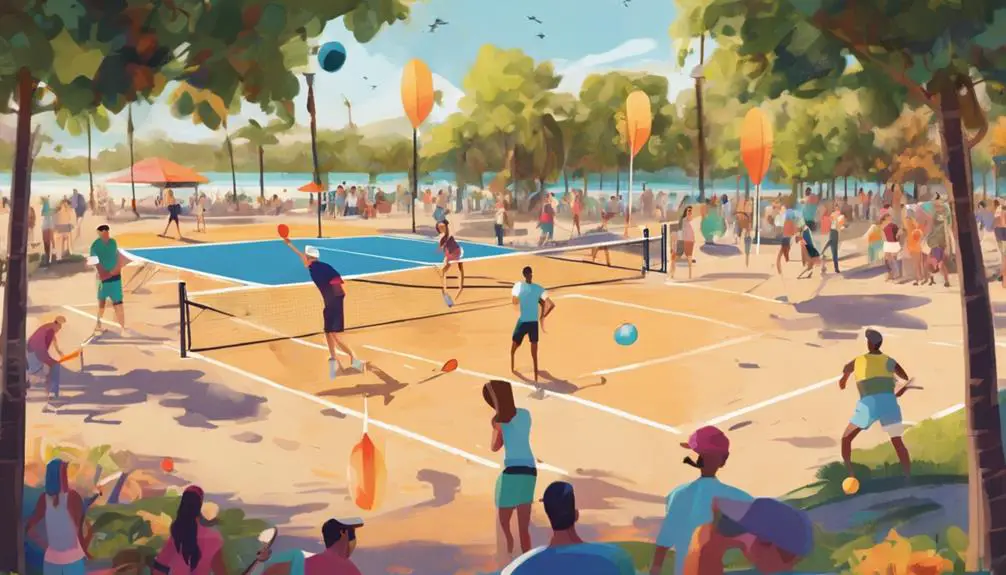
When it comes to selecting the right game for you, understanding your personal preferences and goals is essential. Both paddle ball and pickleball can offer unique experiences, but it’s important to evaluate how each aligns with your lifestyle and desires. Here are some factors to take into account:
- Social Dynamics: If you thrive in a lively environment, pickleball’s doubles format might appeal to you. Paddle ball can be more solitary, which may suit those seeking personal reflection during outdoor activities.
- Competitive Spirit: Are you looking for a friendly match or a heated competition? Pickleball has a strong competitive scene, while paddle ball often attracts a more laid-back vibe, allowing for casual play.
- Family Involvement: Think about who you want to play with. Pickleball’s age suitability makes it an excellent choice for family gatherings, ensuring all ages can join in on the fun. Paddle ball, while versatile, may not engage younger members as effectively.
- Learning Curve: If you’re new to racquet sports, reflect on how quickly you want to pick up the game. Pickleball has a gentler learning curve, which can be encouraging for beginners, while paddle ball may require a bit more practice to master.
Frequently Asked Questions
What Age Groups Typically Play Paddle Ball and Pickleball?
Aren’t you curious about who’s playing? Youth participation is rising, while older adults embrace the game too. Demographic trends show a diverse age range, reflecting a growing interest in both sports across generations.
Can You Play Paddle Ball on a Pickleball Court?
You can play paddle ball on a pickleball court, but be mindful of the court dimensions and game rules. Adapting the space may enhance your experience while allowing for both games’ unique strategies and movements.
Is There a Professional League for Paddle Ball?
There isn’t a widely recognized professional league for paddle ball, but various professional tournaments exist. Understanding paddle ball history reveals its grassroots appeal, suggesting potential growth as enthusiasts seek organized competition and greater recognition in the sports world.
How Do Weather Conditions Affect Each Game?
Weather conditions greatly influence gameplay. Wind impacts ball trajectory, challenging your skills, while surface conditions affect traction and speed. Adapting to these factors can enhance your performance and enjoyment, ensuring a competitive edge in any match.
Are There Specific Shoes Recommended for Paddle Ball or Pickleball?
You’d think any shoe would do, right? Yet, specific shoe features matter on different court surfaces. Look for traction, cushioning, and support to enhance your performance and keep you moving freely without slipping.

